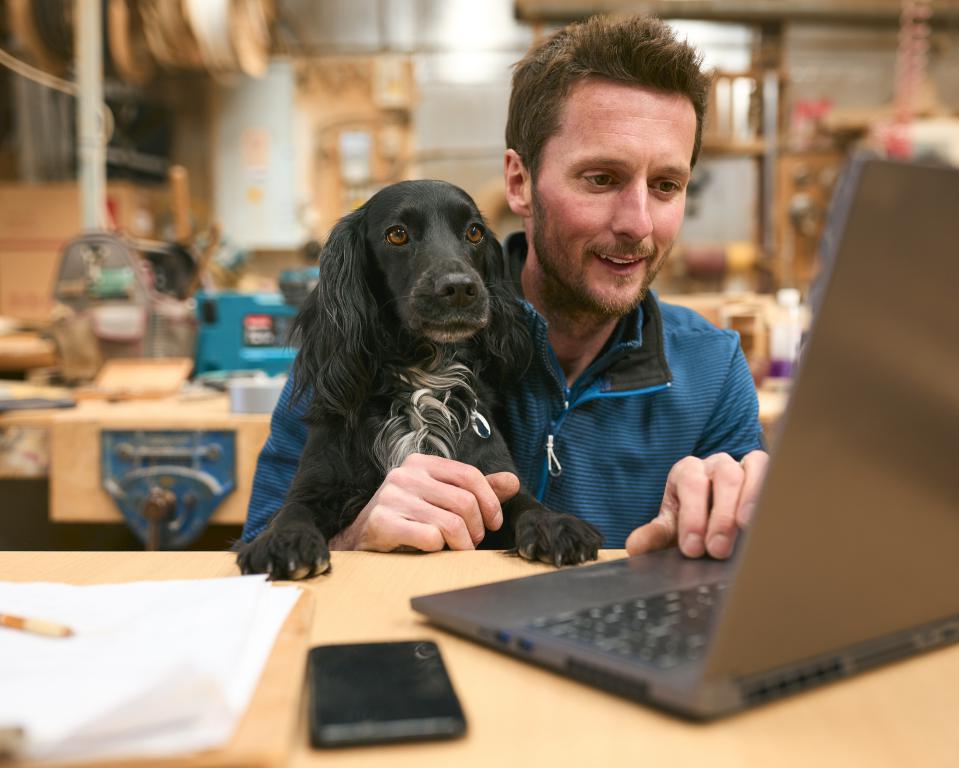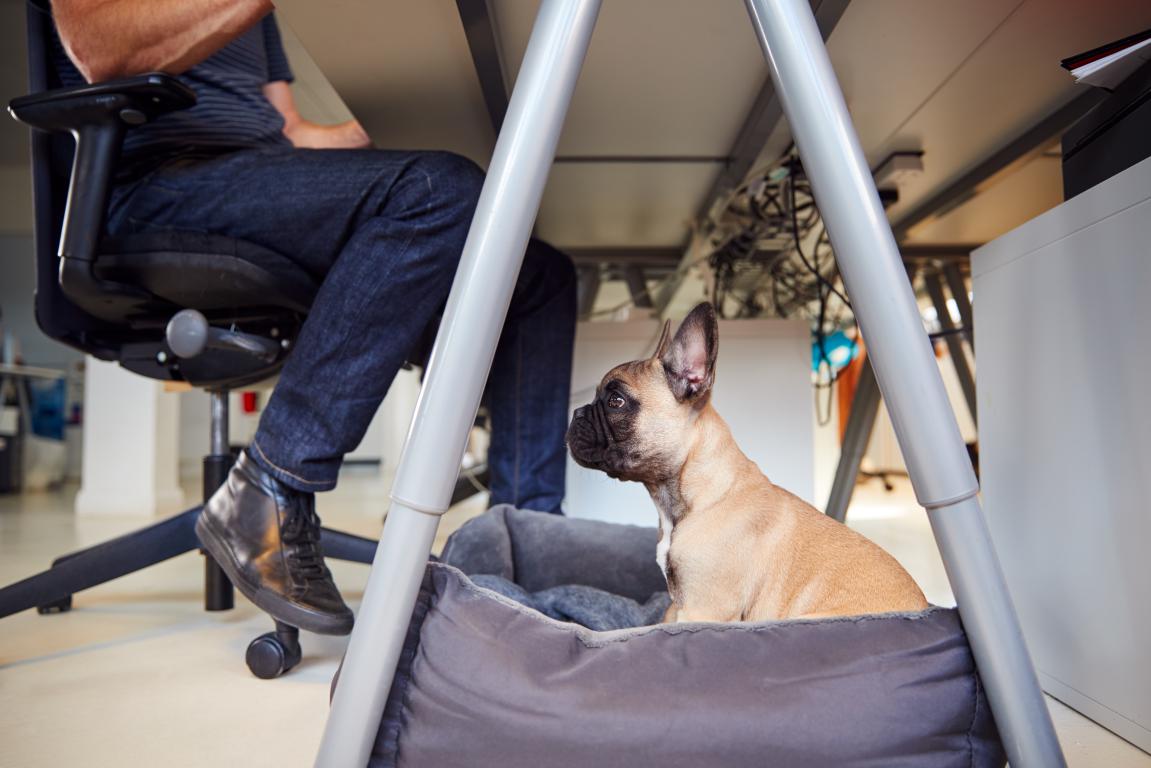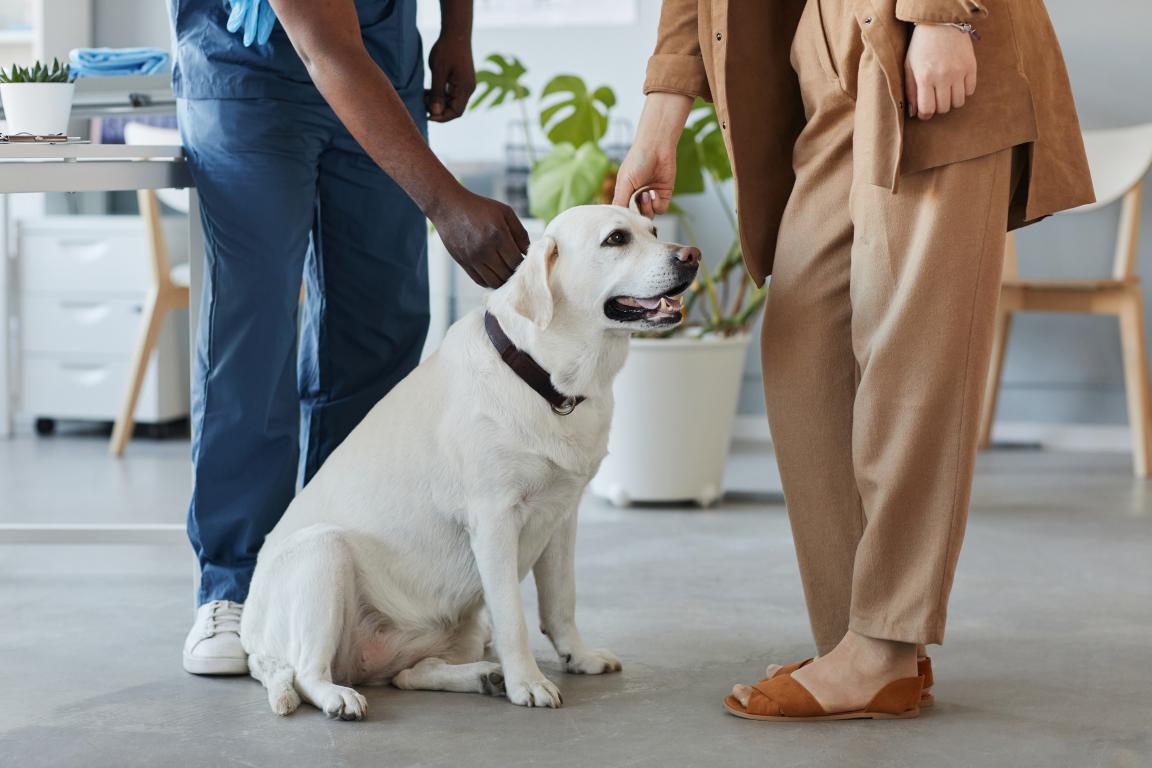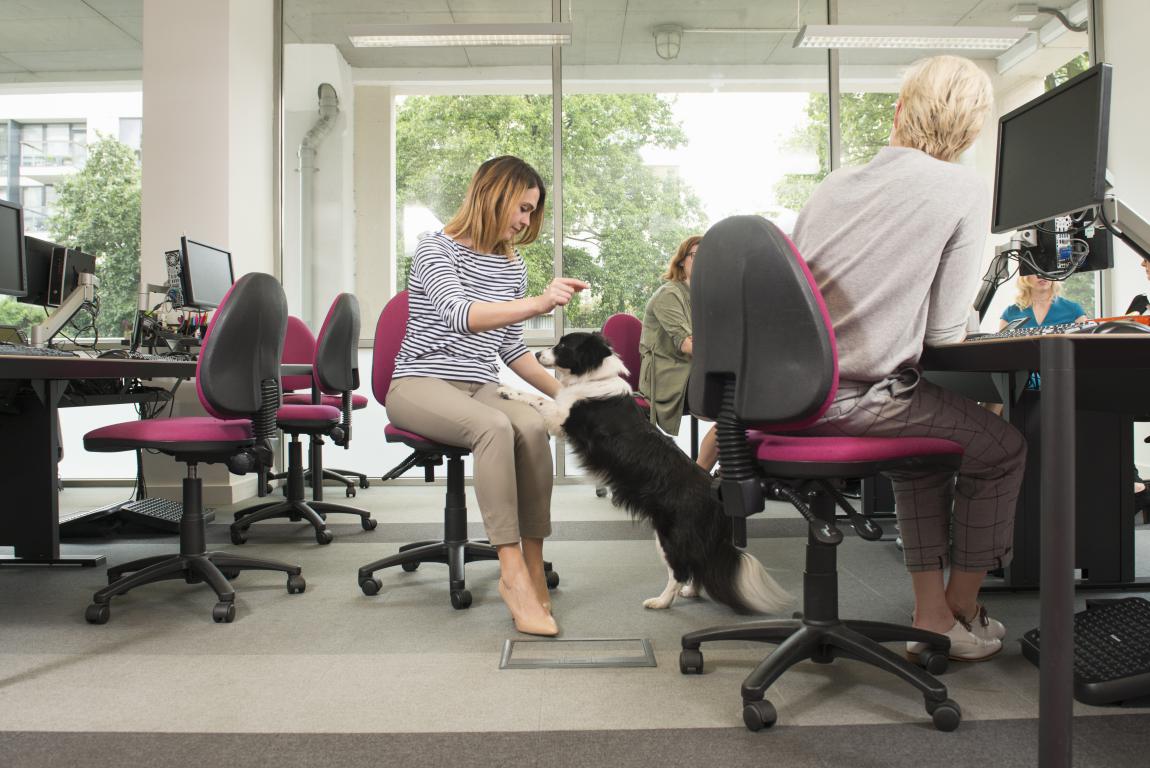Assistance Dogs in the Workplace: Rights and Responsibilities: For owners and employers.
Navigating the world of work with an assistance dog can feel like a maze, both for dog owners and for employers. You might be an assistance dog owner wondering about your rights and how to best communicate your needs, or perhaps you're an employer keen to create an inclusive environment but unsure about your obligations and what to expect. It's completely understandable to have questions; after all, it's a topic that touches on legal rights, practical considerations, and personal well-being. This guide is here to shed light on everything you need to know, providing clear, helpful, and empathetic advice to ensure a smooth and positive experience for everyone involved. We'll walk you through the legal framework, practical steps, and shared responsibilities, making sure you feel confident and well-informed every step of the way.
Table of Contents
Understanding the Legal Landscape: The Equality Act 2010
When we talk about assistance dogs in the workplace in the UK, the first and most important piece of legislation that comes to mind is the Equality Act 2010. This Act is the cornerstone of protecting individuals from discrimination, and it's what gives assistance dog owners their rights. If you're an assistance dog owner, this Act is your shield. If you're an employer, it's your guide to creating a fair and inclusive workplace.
What the Equality Act 2010 Means for You
The Equality Act 2010 essentially makes it illegal to discriminate against someone because of certain 'protected characteristics'. Disability is one of these characteristics. Having an assistance dog is directly linked to a person's disability, and that's why the Act is so crucial. It means that an employer cannot treat an assistance dog owner unfavourably because they have a disability or because they use an assistance dog.
Direct and Indirect Discrimination
It's helpful to understand two main types of discrimination:
-
Direct Discrimination: This is when an employer treats an assistance dog owner less favourably directly because of their disability. For example, if an employer outright refuses to interview someone simply because they mentioned having an assistance dog. This is usually pretty clear-cut and is illegal.
-
Indirect Discrimination: This is a bit more subtle. It happens when an employer has a policy, rule, or practice that applies to everyone but puts people with a protected characteristic (like a disability) at a disadvantage. For instance, a "no dogs allowed" policy might seem fair on the surface, but it would indirectly discriminate against an assistance dog owner unless a reasonable adjustment is made. The Act expects employers to make these 'reasonable adjustments'.
The Duty to Make Reasonable Adjustments
This is perhaps the most vital part of the Equality Act when it comes to assistance dogs in the workplace. Employers have a legal duty to make 'reasonable adjustments' to ensure that disabled employees (or job applicants) are not put at a 'substantial disadvantage' compared to non-disabled employees.
What Does 'Reasonable' Mean?
The term 'reasonable' is key here. It doesn't mean an employer has to do absolutely everything requested, but they do have to take steps that are practical and effective. What's considered reasonable can depend on several factors, including:
-
The effectiveness of the adjustment: How much will it help the assistance dog owner?
-
The practicality of the adjustment: Is it actually possible to implement?
-
The cost of the adjustment: Is it affordable for the employer? Small businesses might have different capabilities than large corporations.
-
The employer's resources: What resources and facilities does the employer have?
-
The impact on other employees: Will the adjustment negatively affect others?
-
The type of job and workplace: An office environment might require different adjustments than a factory floor.
For an assistance dog owner, a reasonable adjustment would almost always include allowing their assistance dog into the workplace. Refusing this would likely put the owner at a substantial disadvantage, as their dog is essential for them to perform their job effectively or even to get to work.
Examples of Reasonable Adjustments for Assistance Dogs
Beyond just allowing the dog, reasonable adjustments might also include:
-
Providing a suitable space for the dog: This could be an area under the desk, or a small, designated resting area nearby.
-
Allowing breaks for the dog: Time for toileting and exercise, which might be outside of standard break times.
-
Adjusting cleaning schedules or methods: If there are allergy concerns, ensuring specific cleaning is done.
-
Educating other staff: Providing information to colleagues about assistance dogs, their role, and appropriate behaviour around them.
-
Modifying policies: For example, adapting a "no pets" policy to explicitly allow assistance dogs.
Who is Protected?
The Equality Act protects disabled people in employment, which includes:
-
Job applicants: You have the right to apply for jobs and attend interviews with your assistance dog.
-
Employees: This covers all aspects of employment, from your day-to-day work to promotions and training opportunities.
-
Contract workers: Even if you're not a direct employee, you're generally covered if you're working under a contract.
Understanding the Equality Act 2010 is the first big step. It empowers assistance dog owners with knowledge of their rights and guides employers in fulfilling their legal and moral obligations to create genuinely inclusive workplaces. It's not just about following the law; it's about fostering an environment where everyone, including those who rely on an assistance dog, can thrive.
What is an Assistance Dog?
Before we dive deeper into rights and responsibilities, it's really important to have a clear understanding of what an assistance dog actually is. When we talk about assistance dogs, we're not just referring to any pet dog that someone brings to work. There's a significant difference, and recognising this is key for both owners and employers.
Defining an Assistance Dog
An assistance dog is specifically trained to perform tasks that mitigate the effects of a person's disability. They are not pets; they are highly skilled working animals, an integral part of their owner's independence and safety. Their training is extensive, rigorous, and usually takes place over many months, often years, with specialised organisations.
Key Characteristics of an Assistance Dog:
-
Highly Trained: This is the most crucial characteristic. Assistance dogs undergo professional, accredited training to perform specific tasks. These tasks aren't just for comfort; they are practical actions directly related to assisting with a disability.
-
Working Animal: They are always 'on duty' when their harness or jacket is on. Their focus is on their owner and their tasks, not on socialising or being distracted.
-
Identifiable: Most assistance dogs wear a recognisable jacket, harness, or lead slip that indicates they are an assistance dog. This helps the public and employers understand their status. While not legally mandatory, it's widely accepted as a way to identify a working dog.
-
Exceptional Behaviour: Due to their training, assistance dogs are typically very well-behaved, calm, and unobtrusive in public and professional settings. They are trained to lie quietly, not wander, not relieve themselves indoors, and not solicit attention.
-
Health and Hygiene: Reputable assistance dog organisations ensure their dogs are healthy, regularly vaccinated, and groomed, minimising any hygiene concerns.
What Tasks Do Assistance Dogs Perform?
The tasks an assistance dog performs are incredibly varied, depending on the owner's disability. Here are some common examples:
-
Guide Dogs: Assist people who are blind or partially sighted to navigate safely, avoiding obstacles.
-
Hearing Dogs: Alert deaf or hard-of-hearing individuals to important sounds like doorbells, smoke alarms, or alarm clocks.
-
Mobility Assistance Dogs: Help individuals with physical disabilities with tasks such as opening doors, retrieving dropped items, pressing pedestrian buttons, or providing stability.
-
Medical Alert Dogs: Can detect subtle changes in their owner's body, such as an impending seizure, changes in blood sugar levels (for diabetes), or other medical emergencies, and alert their owner or summon help.
-
Autism Assistance Dogs: Provide a calming presence, prevent bolting, and help individuals with autism navigate social situations or sensory overload.
-
PTSD Assistance Dogs: Can interrupt anxiety attacks, provide deep pressure therapy, or create a barrier in crowded spaces for individuals with Post-Traumatic Stress Disorder.
It's clear from these examples that an assistance dog isn't just a companion; it's a vital tool that enables its owner to live and work more independently and safely. They aren't there for emotional support in the way a pet might be, although the emotional bond is undoubtedly strong. Their primary role is functional assistance directly linked to a disability.
The Difference Between an Assistance Dog and an Emotional Support Animal (ESA)
This distinction is extremely important, especially in the UK workplace context.
-
Assistance Dog: As described above, an assistance dog is highly trained to perform specific tasks to mitigate a disability. They have public access rights under the Equality Act 2010.
-
Emotional Support Animal (ESA): An ESA is an animal that provides comfort and emotional support to its owner, often alleviating symptoms of mental health conditions. While ESAs can be incredibly beneficial to their owners, they do not have the same legal public access rights as assistance dogs in the UK. This means an employer is not legally obligated under the Equality Act 2010 to permit an ESA in the workplace in the same way they are an assistance dog.
For an employer, understanding this difference is crucial. When an employee requests to bring an animal to work, the first step is to clarify if it is an accredited assistance dog or an emotional support animal. This will determine the legal obligations under the Equality Act.
By having a clear grasp of what constitutes an assistance dog, everyone involved can approach the situation with accurate information, ensuring that the rights of assistance dog owners are respected and that workplaces can confidently make appropriate accommodations. It sets the foundation for a productive and inclusive working relationship.
Rights of Assistance Dog Owners in the Workplace
As an assistance dog owner, you have specific rights in the workplace, primarily protected by the Equality Act 2010. Knowing these rights empowers you to advocate for yourself and ensures you're treated fairly. Your assistance dog isn't a luxury; it's an essential part of your ability to work and live independently, and the law reflects that.
Right to Non-Discrimination
Firstly, you have the right not to be discriminated against because of your disability, which includes your reliance on an assistance dog. This means an employer cannot:
-
Refuse to employ you: If you're the best candidate for a job, your assistance dog should not be a barrier to employment.
-
Deny you promotion or training: Opportunities for career development must be available to you on an equal footing with other employees.
-
Subject you to harassment: Unwanted conduct related to your disability or assistance dog that creates a hostile environment is unlawful.
-
Sack you unfairly: Dismissal due to your need for an assistance dog would likely be considered unfair dismissal and disability discrimination.
This right extends to all aspects of employment, from recruitment and terms of employment to training, transfers, and termination.
Right to Reasonable Adjustments
This is perhaps the most significant right for assistance dog owners. As we discussed, employers have a legal duty to make reasonable adjustments to prevent you from being at a substantial disadvantage due to your disability. For an assistance dog owner, this almost always means:
-
Right to bring your assistance dog to work: This is the fundamental adjustment. Your employer must permit your assistance dog to accompany you in the workplace, unless they can demonstrate it's not a 'reasonable' adjustment – which is very rare for accredited assistance dogs.
-
Right to a safe and suitable space for your dog: Your dog should have an appropriate area to rest quietly near you, ideally out of the main thoroughfare.
-
Right to take your dog out for breaks: Your assistance dog will need toileting and exercise breaks throughout the day, which may not align with standard human break times. You have the right to take these necessary breaks.
-
Right to modifications of policies: If the workplace has a 'no pets' policy, you have the right for this policy to be reasonably adjusted to allow your assistance dog.
-
Right to reasonable consideration of other adjustments: This could include things like accessible routes, modifications to cleaning schedules if allergies are a concern, or access to a secure outdoor space for toileting.
Right to Confidentiality
You have a right to privacy regarding your disability and the specific reasons you have an assistance dog. While you'll need to disclose that you have an assistance dog to your employer to facilitate reasonable adjustments, you don't necessarily have to disclose the intimate details of your disability to all your colleagues. Your employer should handle your personal information sensitively and confidentially, sharing it only on a 'need-to-know' basis to implement adjustments and inform relevant staff.
Right to Challenge Unfavourable Treatment
If you believe your rights are being violated, or you're being treated unfavourably because of your assistance dog, you have the right to challenge this. This typically involves:
-
Raising the issue informally: Initially, you might try to resolve it directly with your line manager.
-
Following your employer's grievance procedure: If an informal approach doesn't work, you can lodge a formal grievance. Your employer should have a clear procedure for this.
-
Seeking external advice: Organisations like ACAS (Advisory, Conciliation and Arbitration Service), Citizens Advice, or a solicitor specialising in employment law can offer guidance and support.
-
Making a claim to an Employment Tribunal: As a last resort, if internal procedures and conciliation efforts fail, you can pursue a claim for discrimination in an Employment Tribunal.
Right to Be Consulted
When reasonable adjustments are being considered, you have the right to be consulted. Your employer should discuss with you what adjustments are needed and how they can best be implemented. You are the expert on your needs and how your assistance dog helps you, so your input is invaluable. This is a collaborative process, not a unilateral decision by the employer.
Understanding these rights is crucial. They are there to ensure that your disability, and your reliance on an assistance dog, does not prevent you from fully participating and succeeding in the workplace. While these rights exist, remember that clear and open communication with your employer is often the most effective way to ensure they are respected and implemented smoothly.
Responsibilities of Assistance Dog Owners in the Workplace
While you have significant rights as an assistance dog owner in the workplace, these come hand-in-hand with important responsibilities. Fulfilling your responsibilities helps to ensure a smooth, positive experience for everyone, building trust with your employer and colleagues, and maintaining the excellent reputation of assistance dogs. It’s all about creating a harmonious environment where your dog is welcomed and understood.
Informing Your Employer
One of your primary responsibilities is to inform your employer as early as possible about your intention to bring an assistance dog to work.
-
During the application process: Ideally, you should mention it when applying for a job, or at least during the interview stage. This allows the employer to consider reasonable adjustments from the outset.
-
Before starting a new role: If you already have the job, inform them well in advance of your start date.
-
As soon as the need arises: If you acquire an assistance dog during your employment, inform your employer as soon as possible.
This early notification gives your employer time to understand their obligations, assess any potential impacts, and discuss the necessary reasonable adjustments with you. It shows proactive communication and a willingness to collaborate.
Providing Necessary Documentation (If Requested)
While you don't have to provide specific certification in the UK (as there's no single legal registry for assistance dogs), it's reasonable for an employer to ask for some form of verification.
-
Proof of training: You should be prepared to provide documentation from the assistance dog organisation that trained your dog, confirming their status and training. This could be a letter, certificate, or ID card.
-
Confirmation of need: Your employer might ask for a letter from a medical professional (like your GP or specialist) confirming that you have a disability and that an assistance dog assists you in mitigating the effects of that disability. This helps them understand their duty to make reasonable adjustments.
Remember, the employer isn't asking to be difficult; they're often trying to understand their legal obligations and make the right accommodations. Providing this information clearly and promptly can streamline the process.
Ensuring Your Dog is Well-Behaved and Under Control
This is perhaps the most critical practical responsibility. Your assistance dog is a working animal, and their behaviour reflects on both you and the concept of assistance dogs in general.
-
Impeccable behaviour: Your dog must be calm, quiet, and unobtrusive in the workplace. This means no barking, jumping up, running around, or approaching colleagues without invitation.
-
Leash control: Your dog should always be under your control, typically on a lead when moving around the workplace, and settled quietly near you when at your workstation.
-
No disruption: Your dog should not disrupt the work of others, interfere with equipment, or create any hazards.
-
Toileting: Your dog must be fully house-trained and only relieve themselves in appropriate outdoor areas designated by you or your employer. Any accidents should be promptly and thoroughly cleaned up by you.
Maintaining a high standard of behaviour from your dog helps reassure colleagues and management, fostering acceptance and reducing concerns.
Maintaining Your Dog's Health and Hygiene
You are responsible for your dog's well-being and ensuring they don't pose a health risk to others.
-
Regular veterinary care: Your dog should be up-to-date on all vaccinations, flea and worming treatments.
-
Grooming: Keep your dog clean and well-groomed to minimise shedding, odours, and potential allergens.
-
Food and water: You are responsible for bringing your dog's food and water, and ensuring they are fed and watered at appropriate times, without creating mess or attracting pests.
-
Cleaning up waste: You must always clean up after your dog immediately and dispose of waste hygienically.
Managing Your Dog's Needs
You are responsible for all aspects of your dog's daily care while at work.
-
Breaks: You need to manage your time to ensure your dog gets regular toileting and exercise breaks.
-
Supervision: Your dog should generally be with you or in a pre-agreed, secure resting area. You cannot expect colleagues to take responsibility for your dog's care.
-
Emergency plan: Have a plan in place for your dog's care if you become unwell or there's an emergency at work.
Respecting Others and Workplace Policies
While your rights are paramount, you also have a responsibility to be mindful of your colleagues and the wider workplace environment.
-
Communication: Be open to discussing concerns with your employer and colleagues. Address issues proactively and empathetically.
-
Allergies and phobias: While the presence of an assistance dog is a reasonable adjustment, you should be understanding if colleagues express concerns about severe allergies or phobias. This is where collaboration and finding solutions (e.g., designated work zones, air purifiers, specific cleaning) become important. You should be prepared to cooperate with your employer in finding solutions that accommodate everyone where possible.
-
Workplace rules: Adhere to any agreed-upon rules or guidelines regarding your dog's presence, such as specific routes to enter/exit the building, designated toileting areas, or areas that are off-limits (e.g., cleanrooms).
By upholding these responsibilities, you not only ensure your own comfort and productivity but also contribute to a respectful and inclusive workplace culture that welcomes assistance dogs. It's a partnership between you and your employer, built on clear communication and mutual understanding.
Responsibilities of Employers Regarding Assistance Dogs
For employers, understanding your responsibilities when an employee needs to bring an assistance dog to work isn't just about legal compliance; it's about fostering an inclusive, supportive, and productive environment. When you properly accommodate an assistance dog, you’re not just following the law, you’re enabling a valuable employee to thrive.
Legal Duty to Make Reasonable Adjustments
As established by the Equality Act 2010, your primary legal responsibility is to make reasonable adjustments to ensure that a disabled employee (or job applicant) is not placed at a 'substantial disadvantage' because of their disability. For an assistance dog owner, this almost always means:
-
Permitting the assistance dog in the workplace: This is the most fundamental adjustment. You must allow the assistance dog to accompany its owner, unless you can demonstrate that doing so would not be a 'reasonable' adjustment due to a compelling and justifiable reason. Such reasons are rare for accredited assistance dogs.
-
Consultation with the employee: You have a responsibility to discuss the adjustments with the employee. They are the expert on their own needs and how their assistance dog assists them. Your discussions should be collaborative and focus on finding effective solutions.
-
Assessing what is 'reasonable': You must genuinely consider what adjustments are reasonable in your specific workplace, taking into account the effectiveness, practicality, cost, and impact on your business and other staff. This isn't about finding reasons to refuse; it's about finding ways to accommodate.
Conducting a Risk Assessment
It's good practice, and often a legal requirement under health and safety legislation, to conduct a risk assessment for the presence of an assistance dog in the workplace. This isn't about finding reasons to exclude the dog, but rather to identify and mitigate any potential risks.
-
What to assess: Consider potential risks such as allergies, phobias, trip hazards (e.g., lead), hygiene, and the dog's behaviour.
-
How to mitigate: The risk assessment should then outline how these risks will be managed. For example:
-
Allergies: Discuss with the employee, consider air purifiers, increased cleaning in specific areas, or rearranging seating where possible. Note that a mild allergy alone is unlikely to be a justifiable reason to refuse an assistance dog.
-
Phobias: Again, discuss with affected staff. Strategies could include designated pathways, quiet areas, or clear communication about the dog's presence.
-
Trip hazards: Ensure the dog has a designated space and that leads are managed appropriately.
-
Hygiene: Ensure the employee has a plan for toileting and waste disposal.
-
Review and update: Risk assessments should be reviewed periodically and updated if circumstances change.
Communicating with Other Employees
You have a responsibility to inform and educate other employees about the presence of an assistance dog.
-
Information sharing: Provide clear, factual information about what an assistance dog is, its role, and why it is in the workplace.
-
Guidance on interaction: Educate staff on appropriate behaviour around an assistance dog (e.g., don't distract, pet, or feed the dog without permission).
-
Addressing concerns: Create an open channel for other employees to raise legitimate concerns (e.g., severe allergies or genuine phobias) respectfully. It's your responsibility to mediate and find solutions that accommodate everyone where reasonably possible.
-
Maintaining confidentiality: While informing staff about the dog's presence, remember to respect the owner's privacy regarding the specifics of their disability.
Providing Suitable Facilities
Beyond just allowing the dog, you should consider what facilities might be reasonably needed.
-
Designated toileting area: Identify or create a suitable, accessible outdoor area for the dog to relieve itself, if feasible, and ensure there's a bin for waste disposal.
-
Water access: Ensure there's a convenient and safe place for the dog to access water, or facilitate the owner bringing their own water bowl.
-
Space: Ensure there's enough space around the employee's workstation for the dog to rest comfortably and safely without obstructing walkways.
Reviewing and Adapting Policies
You may need to review and adapt existing workplace policies.
-
'No pets' policy: Your 'no pets' policy will need to be adjusted to explicitly allow assistance dogs as a reasonable adjustment under the Equality Act.
-
Emergency procedures: Incorporate the assistance dog into emergency evacuation plans. Who will assist the dog if the owner is incapacitated?
-
Visitor policies: Ensure that any policies for visitors or clients also accommodate assistance dogs.
Ongoing Support and Management
Your responsibility doesn't end once the dog is in the workplace.
-
Support for the employee: Continue to check in with the employee to ensure the arrangements are working well and address any emerging issues.
-
Support for other staff: Be available to discuss ongoing concerns from other staff and seek solutions.
-
Mediation: If conflicts arise (e.g., between an assistance dog owner and a colleague with a severe phobia), it's your responsibility to mediate and find reasonable resolutions.
By embracing these responsibilities, employers can demonstrate a true commitment to diversity and inclusion, creating a workplace where assistance dog owners feel valued and empowered, and where the presence of an assistance dog is seamlessly integrated into the daily routine. It's a positive step towards a truly accessible working world.
Practical Considerations for a Dog-Friendly Workplace
Beyond the legal duties, there are many practical steps employers can take to ensure the smooth integration of an assistance dog into the workplace. Thinking proactively about these practicalities can prevent issues, foster acceptance, and create a truly welcoming environment for both the employee and their canine companion. It's about making the theory of inclusion work in everyday reality.
Pre-Arrival Planning and Communication
Effective planning starts before the dog even sets paw in the office.
-
Initial meeting: Have a meeting with the assistance dog owner. Discuss their specific needs, the dog's routine, and any concerns they might have. This is also the time to clarify expectations for both sides.
-
Workplace tour: Walk through the workplace with the employee and, if appropriate, their dog. Identify the best route in and out, the dog's designated resting area, and potential toileting spots. This helps to pinpoint any physical barriers or logistical challenges that need addressing.
-
Key stakeholder communication: Inform relevant departments and individuals. This includes the employee's direct team, HR, facilities management, and health and safety officers. Ensure everyone knows what to expect and understands their role in supporting the arrangement.
-
"Meet and Greet" (Optional but Recommended): A controlled, supervised "meet and greet" session with immediate team members can be incredibly beneficial. It allows colleagues to meet the dog in a relaxed setting, ask questions, and learn about appropriate behaviour around a working dog. This can significantly reduce anxiety and foster acceptance.
Designing the Workspace and Facilities
Small adjustments to the physical environment can make a big difference.
-
Designated resting area: Ensure there's a clear, safe, and comfortable space for the dog to rest near its owner. This might be under the desk, beside the desk, or in a small, pre-agreed area nearby. It should be out of main walkways to avoid trip hazards.
-
Food and water: Discuss with the employee where they will keep their dog's food and water bowls. Ensure it's a hygienic spot, away from foot traffic and electrical equipment.
-
Toileting area: Identify a suitable, easily accessible outdoor area for the dog to relieve itself. Ensure there's a waste bin nearby for disposal. If the workplace doesn't have suitable green space, consider if a small, contained area could be adapted, or clarify the nearest public accessible area.
-
Access routes: Confirm the most convenient and least disruptive route for the employee and their dog to enter and exit the building, especially if there are security gates or revolving doors.
-
Emergency procedures: Update emergency evacuation plans to include the assistance dog. Who will assist the dog if the owner is incapacitated? How will the dog be safely evacuated?
Addressing Health and Safety Concerns
A thorough, proactive approach to health and safety is crucial.
-
Allergies:
-
Gather information: If colleagues express allergy concerns, gather details on the severity and specific triggers.
-
Mitigation strategies: Consider strategies like increased cleaning, air purifiers, re-arranging seating (if possible and practical), or creating designated 'dog-free' zones for severely allergic individuals. A mild allergy is generally not a reason to refuse an assistance dog, but severe, life-threatening allergies would require serious consideration and potentially creative solutions.
-
Phobias:
-
Empathy and education: Acknowledge genuine phobias with empathy. Educate the colleague about the assistance dog's role and calm temperament.
-
Physical separation: If a severe phobia exists, strategies might include creating a physical barrier, establishing a specific route the dog will use, or even allowing the phobic colleague to work in a different area of the office.
-
Hygiene: Ensure regular cleaning schedules are maintained. Clarify the employee's responsibility for cleaning up any accidents immediately and hygienically. Provide access to cleaning supplies.
-
Trip hazards: Emphasise that the dog should be settled and out of the way. Leads should be kept short and close to the owner when moving.
Education and Awareness for All Staff
Ongoing education is vital for fostering a truly inclusive environment.
-
Information pack/intranet resource: Create an accessible resource (e.g., a page on the company intranet) explaining the company's policy on assistance dogs, what an assistance dog is, and how to interact respectfully with one (e.g., "do not distract, pet, or feed the dog without permission").
-
Workshops/briefings: Consider holding short, informal briefings for teams, especially new employees, to reinforce the information.
-
Designated contact: Have a designated HR or line manager contact person for any questions or concerns about assistance dogs.
Review and Feedback
It’s important to see the integration of an assistance dog as an ongoing process, not a one-off event.
-
Regular check-ins: Schedule regular check-ins with the assistance dog owner to discuss how things are working and address any new challenges.
-
Feedback channels: Maintain open channels for other employees to provide feedback or raise concerns constructively.
-
Adjustments as needed: Be prepared to make further reasonable adjustments as circumstances change or new issues arise.
By carefully considering and implementing these practical steps, employers can move beyond mere compliance to create a truly supportive and functional workplace where assistance dogs are seamlessly integrated, benefiting both the individual employee and the wider company culture. It helps everyone understand their role in making the arrangement a success.
Addressing Concerns and Resolving Disputes
Even with the best intentions and thorough planning, questions, concerns, or even disputes can sometimes arise when an assistance dog is in the workplace. What's important is how these are addressed – with empathy, clear communication, and a focus on finding reasonable solutions. For both assistance dog owners and employers, knowing the steps to take can prevent minor issues from escalating. It's about being prepared and knowing how to navigate those trickier conversations to keep things smooth and fair for everyone.
For Assistance Dog Owners: Raising Concerns
If you, as an assistance dog owner, encounter issues or feel your rights aren't being met, it's important to address them systematically. You've got rights, and there are ways to make sure they're respected.
-
Try to sort it out informally first:
-
Chat with your line manager: Often, a simple misunderstanding or a bit of unawareness can be sorted out with a direct, calm conversation with your immediate manager. Explain what's going on, gently remind them of your rights, and maybe suggest how you think it could be fixed. Most people want to do the right thing, and sometimes they just need a bit of a nudge or more information.
-
Keep a record of everything: This is a really important tip. Jot down dates, times, who you spoke to, what you talked about, and anything you both agreed to do. This record becomes super helpful if the problem doesn't go away or if it gets a bit more serious. It's your personal logbook of what's happened.
-
Follow your employer's formal grievance procedure:
-
If those informal chats don't get you anywhere, or if the issue feels more serious (like someone is constantly discriminating against you, or they're just flat-out refusing to make reasonable adjustments), then it's time to use your employer's official grievance procedure. You'll usually find details of this in your employee handbook or on the company's internal policies page.
-
A formal grievance usually means you'll put your concerns in writing, then have a meeting to talk it through, and finally, you'll get a formal response from your employer. It’s a bit more official, but it’s there to protect you.
-
Don't be afraid to get outside help:
-
ACAS (Advisory, Conciliation and Arbitration Service): These guys are brilliant. They offer free, impartial advice to both employees and employers on all things workplace rights and best practices. They can give you really good guidance on your rights and how to approach your employer.
-
Citizens Advice: They're another great resource for general advice on employment rights and discrimination. They can help you understand your situation.
-
Trade Union/Professional Association: If you're a member of a union or a professional association, they can offer fantastic support, advice, and even represent you if needed.
-
Solicitor: If things are getting really complicated or serious, and you feel like you're not getting anywhere, it might be worth speaking to a solicitor who specialises in employment law. They can give you tailored legal advice.
-
Your Assistance Dog Organisation: The organisation that trained your dog might also be able to offer specific advice or support, as they deal with these situations a lot.
-
Employment Tribunal (as a last resort): If you've tried everything else and it's still not resolved, you might consider taking a claim to an Employment Tribunal for disability discrimination under the Equality Act 2010. This is a big step and a formal legal process, so you'll definitely need professional legal advice before going down this road.
For Employers: Addressing Concerns from Colleagues or the Assistance Dog Owner
Employers, you've got a responsibility to deal with all concerns quickly and fairly. Your aim is to find a solution that respects everyone's rights and needs. It's about being a good mediator and finding a path forward.
-
Listen with an open mind: When someone raises a concern, whether it's the assistance dog owner or another colleague, really listen without judging. Acknowledge how they're feeling and show them you understand their point of view.
-
Look into the concern properly: Get the facts. What exactly is the problem? When did it happen? Who was involved? Getting a clear picture helps you find the right solution.
-
Keep things confidential: Always handle personal information sensitively and keep it private, especially when it comes to an employee's disability or health conditions. Share information only on a 'need-to-know' basis.
-
Mediate and encourage discussion:
-
If the concern involves another employee (maybe someone has an allergy or a phobia), try to get the people involved to talk to each other (with their permission, of course). You'd act as a neutral person, helping them communicate.
-
Your main goal here is to find practical, reasonable solutions that minimise any negative impact on anyone.
-
Revisit your risk assessment and reasonable adjustments:
-
If a new concern comes up, go back to your initial risk assessment. Are there new risks you hadn't thought about? Can the existing reasonable adjustments be changed or improved to fix the problem?
-
For example, if a severe allergy suddenly pops up, could you think about moving desks, getting some air purifiers, or stepping up the cleaning in certain areas?
-
Educate and remind staff: Sometimes, concerns just come from people not really understanding. Gently remind staff about assistance dogs, what they do, and how to behave respectfully around them. A quick refresh can go a long way.
-
Document everything: Just like with the employee, keep really detailed records of all concerns, any investigations you did, conversations you had, and what actions were taken. This protects everyone.
-
Get outside advice (if you need it): If you're finding it tough to figure out a solution, don't hesitate to reach out to ACAS or an employment law specialist. They can give you guidance on tricky situations and help make sure you're meeting all your legal duties.
Common Areas of Dispute and How to Approach Them
Sometimes, specific issues pop up more often. Here’s how you can usually think about them:
-
Allergies: As an employer, you're juggling your duty to make reasonable adjustments for the assistance dog owner with your need to protect other employees' health. A severe, life-threatening allergy might, in very rare cases, create a really tough challenge. But before you even think about anything else, you absolutely must explore every single possibility for reducing the risk – things like separate work areas, better ventilation, or specific cleaning routines. It’s highly unlikely that a mild allergy alone would be a good enough reason to refuse an assistance dog.
-
Phobias: Acknowledge that a severe phobia can cause genuine distress. Solutions here often involve creating physical space, setting up clear 'safe' zones for the person with the phobia, and sometimes, if the individual is willing and under professional guidance, a very controlled, gradual introduction.
-
Dog behaviour: If the assistance dog's behaviour is genuinely causing problems (like constant barking, toileting accidents, or approaching colleagues when it shouldn't), then the employer has every right to talk to the owner about it. The owner is responsible for their dog's behaviour, and if issues keep happening, it might mean you need to review the agreement. But this should always start with offering support to the owner to help them manage their dog, not immediately jumping to exclusion.
-
Misunderstanding of roles: Sometimes, colleagues might forget that an assistance dog is working and treat it like a pet. Education and gentle reminders from the employer can really help clarify that the dog is on duty and should be left alone.
Resolving disputes requires a commitment from all sides to communicate openly and seek solutions that everyone can agree on. By approaching concerns with empathy and a focus on practical adjustments, employers can ensure their workplace remains inclusive and harmonious for everyone, including those who rely on an assistance dog. It’s all about working together.
Creating an Inclusive and Welcoming Environment
Beyond just meeting legal obligations, the real goal is to create a workplace where an assistance dog and their owner don't just 'fit in,' but truly feel welcome and supported. This goes a step further than just making adjustments; it's about fostering a culture of understanding and respect. When everyone feels comfortable and valued, the whole team benefits.
Leading with Empathy and Positive Reinforcement
As an employer, your attitude sets the tone.
-
Positive messaging: Clearly communicate that the presence of an assistance dog is a positive step towards a diverse and inclusive workplace. Frame it as an asset, not a burden.
-
Role modelling: Managers and leaders should visibly support the assistance dog and their owner, interacting respectfully and setting an example for other staff.
-
Celebrate diversity: Use the opportunity to reinforce the organisation's commitment to diversity and inclusion in all its forms.
Ongoing Education and Awareness
Initial training is important, but a truly inclusive environment comes from continuous learning.
-
Regular reminders: Occasionally send out gentle reminders about assistance dogs and appropriate behaviour, perhaps in a company newsletter or team meeting. This helps new staff and refreshes the memory of others.
-
"Did You Know?" facts: Share interesting facts about assistance dogs or the specific tasks the employee's dog performs (with the employee's permission). This can turn curiosity into appreciation.
-
Address myths and misconceptions: Be prepared to politely correct any misinformation or outdated views that might surface. Education is a powerful tool against prejudice.
Creating Clear Guidelines and Policies
While the Equality Act provides the framework, clear internal guidelines help everyone know where they stand.
-
Assistance Dog Policy: Develop a clear, written policy that outlines the process for employees requesting to bring an assistance dog, the employer's responsibilities, and the employee's responsibilities. This should be easily accessible to all staff.
-
Code of Conduct around Assistance Dogs: Include simple, easy-to-understand guidelines for all employees on how to interact with an assistance dog (e.g., "Do not pet without asking," "Do not offer food," "Do not distract a working dog").
-
Review and update: Regularly review these policies to ensure they remain relevant and effective.
Supporting Social Integration
Help colleagues understand the working role of the dog, but also recognise the unique bond.
-
"Ask me about my dog" moments: Encourage the assistance dog owner to share appropriate information about their dog's role, if they feel comfortable. This can demystify the situation for colleagues.
-
Respect boundaries: Ensure colleagues understand that while they should be respectful of the dog's working role, they don't need to ignore the dog entirely. Polite questions to the owner are fine, but the dog should never be distracted from its duties.
-
Offer practical support: Sometimes, colleagues can offer small, practical kindnesses, like holding a door open or ensuring a clear path, which simply demonstrates consideration.
Empowering the Assistance Dog Owner
Ensure the employee feels empowered to manage their situation.
-
Voice their needs: Encourage the employee to openly communicate their needs or concerns without fear of judgment.
-
Advocate for their dog: Support them in gently educating colleagues who might be unknowingly distracting their dog.
-
Feel secure: Ensure they feel secure in their role and know that their assistance dog is a valued part of their ability to perform it.
By taking these steps, employers can move beyond simply 'allowing' an assistance dog to creating a truly inclusive and supportive workplace culture. It's about recognising that an assistance dog isn't just an accommodation; it's an enabler, contributing to a diverse workforce where everyone has the opportunity to thrive. A welcoming environment benefits the assistance dog owner, their colleagues, and ultimately, the entire organisation.
Beyond the Workplace: More About Assistance Dogs and The Equality Act 2010
We've covered a lot about how assistance dogs fit into the world of work, outlining the rights of owners and the responsibilities of employers. It's a really important area, but it's just one piece of the puzzle when it comes to understanding assistance dogs and the law. The Equality Act 2010 doesn't just apply to the workplace; its protections for assistance dog owners extend into many other areas of daily life.
If you're an assistance dog owner, or an employer looking to truly understand the broader context, it's incredibly helpful to know that these principles of non-discrimination and reasonable adjustment apply in various public and private settings. This means that access to shops, restaurants, public transport, housing, and other services should also be readily available to assistance dog users.
For a deeper dive into these wider applications of the law, and to explore all the places where assistance dogs have a right to go and why, we've put together another comprehensive guide. It's packed with information that will help you understand the full scope of what it means to be an assistance dog owner in the UK, or how to fully comply with the law in any public-facing role.
We encourage you to check out our main information guide: What You Need To Know About Assistance Dogs and The Equality Act 2010. It will give you an even fuller picture, making sure you're completely informed on all aspects of this vital topic.
© 2024 The Card Project Uk Ltd
VAT: 453 2087 06
|








